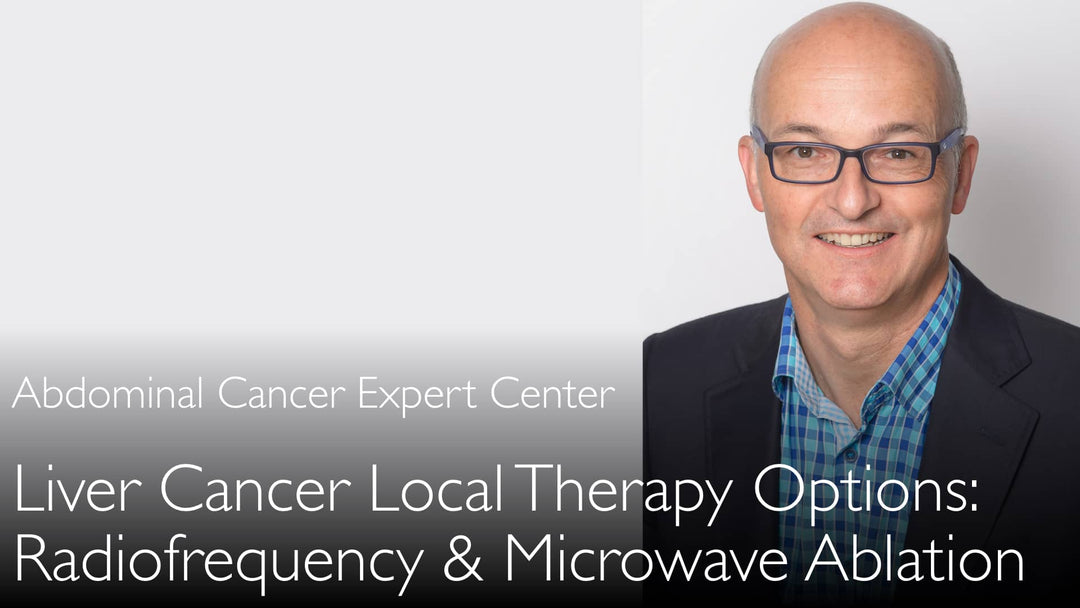מומחה מוביל בניתוחי סרטן הכבד, ד"ר כריסטוף מאורר, MD, מסביר כיצד צריבה בגלי רדיו (RFA) וצריבה בגלי מיקרו (MWA) מטפלות בגידולי כבד. טכניקות צריבה אלו הן כלים חיוניים הן לסרטן כבד ראשוני והן לגרורות בכבד. הן מתאימות ביותר לגידולים קטנים עד קוטר של 3 ס"מ. צריבה יכולה להימנע מכריתה נרחבת של הכבד ולעיתים משולבת עם ניתוח. ההליך מפעיל חום להשמדת הגידול ושוליים בטוחים של רקמה סביבו. ההצלחה תלויה בניסיון צוות הכירורגים ובמיקום מחט מדויק בהנחיית אולטרסאונד.
צריבה של גידולים בכבד: RFA ו-MWA לסרטן ראשוני וגרורתי
קפיצה לפרק
- הסבר על טכניקות הצריבה
- מועמדים אידיאליים לצריבה
- יישומים קליניים ויתרונות
- ההליך וגורמי הצלחה
- השוואה בין צריבה לכריתה
- עתיד הטיפול בסרטן הכבד
- תמליל מלא
הסבר על טכניקות הצריבה
צריבה בתדר רדיו (Radiofrequency ablation, RFA) וצריבה בגלי מיקרו (Microwave ablation, MWA) הן טכניקות פולשניות מינימליות להרס גידולים בכבד. ד"ר כריסטוף מאורר, MD, מתאר את התהליך כיישום חום ישירות לגידול באמצעות מחט המוחדרת לכבד. חום זה, הנוצר מאנרגיית רדיו או גלי מיקרו, גורם לנמק של תאי הסרטן. גם שוליים קטנים של רקמת כבד תקינה מסביב עוברים נמק כדי ליצור שולי ביטחון קריטיים סביב הגידול הכרות.
מועמדים אידיאליים לצריבה
החולים המתאימים ביותר לצריבה של גידולים בכבד הם אלה עם נגעים קטנים. ד"ר כריסטוף מאורר, MD, מדגיש שטכניקות אלה מיטביות עבור גידולים עד שלושה סנטימטרים בקוטר. מגבלת גודל זו היא מפתח להשגת שיעור גבוה של נמק גידולי מלא. הצריבה יעילה במיוחד עבור גידולים הממוקמים במרכז הכבד, שם כריתה כירורגית מסורתית הייתה ניתוח גדול ומורכב.
יישומים קליניים ויתרונות
צריבה של גידולים בכבד יעילה הן עבור סרטן כבד ראשוני, כמו קרצינומה של תאי כבד, והן עבור מחלה גרורתית משנית, כמו מסרטן המעי הגס. יתרון משמעותי הוא היכולת לשלב צריבה עם כריתה כירורגית. כפי שמסביר ד"ר כריסטוף מאורר, MD, מנתח יכול לבצע צריבה באונה אחת של הכבד וכריתה באחרת. טיפול משולב זה מרחיב מאוד את ספקטרום הסרטנים הניתנים לטיפול ומשפר את הכריתה הכוללת, ומציע לחולים סיכוי נוסף לריפוי.
ההליך וגורמי הצלחה
הליך הצריבה תלוי heavily בדייקנות ובניסיון. זה לא רק עניין של הצבת מחט ויישום חום. ד"ר כריסטוף מאורר, MD, מדגיש שצוות הכירורגים חייב לוודא שהמחט נמצאת במיקום הנכון, דבר שאומת באמצעות הדרכת אולטרסאונד תוך ניתוחית. האמינות וההצלחה של צריבה בתדר רדיו או צריבה בגלי מיקרו קשורות ישירות למיומנות המפעיל ולנוחותו עם הטכנולוגיה.
השוואה בין צריבה לכריתה
עבור הגידולים המתאימים, תוצאות הצריבה יכולות להיות שוות ערך לכריתה כירורגית. ד"ר מאורר מאשר שעבור גידולי סרטן כבד קטנים מתחת לשלושה סנטימטרים, צריבה נחשבת יעילה באותה מידה. זה הופך אותה לאלטרנטיבה אלגנטית ופחות פולשנית לכריתת כבד גדולה. השיחה עם ד"ר אנטון טיטוב, MD, מדגישה שהבחירה בין הטכניקות לרוב תלויה בתרחיש הקליני הספציפי ובמומחיות צוות הכירורגים.
עתיד הטיפול בסרטן הכבד
כלים חדשניים אלה של צריבה מייצגים התקדמות משמעותית בניתוחי סרטן הכבד. ד"ר כריסטוף מאורר, MD, מתאר אותם כשיטות מדהימות החשובות מאוד לחולים. על ידי מתן אפשרות פולשנית מינימלית שניתן להשתמש בה alone או בשילוב עם ניתוח, טכנולוגיית הצריבה מרחיבה את אפשרויות הטיפול. כפי שד"ר אנטון טיטוב, MD, דן, התקדמות זו מציעה תקווה חדשה ופוטנציאל ריפוי עבור אנשים עם גידולי כבד ראשוניים וגרורתיים.
תמליל מלא
קיימות אפשרויות רבות לטיפול בגרורות כבד וריאות בסרטן המעי הגס. מתי להשתמש בצריבה בתדר רדיו (RFA) וצריבה בגלי מיקרו (MWA) בטיפול בגידולי כבד? סרטן כבד ראשוני ונשאים גרורתיים בכבד מסרטן המעי הגס ניתנים לטיפול יעיל.
ד"ר אנטון טיטוב, MD: בוא נדבר על סרטן הכבד. יש סרטן כבד ראשוני, כמו קרצינומה של תאי כבד. יש סרטן כבד משני, כמו סרטן מעי גס גרורתי. השכיחות שלהם גבוהה ועולה בתדירות. כריתה כירורגית של גידולי כבד היא אפשרות הטיפול העיקרית. אבל צריבה בתדר רדיו של גידולי כבד גם התקדמה מאוד לאחרונה.
שיתפת פעולה בסקירה מקיפה על שיטות הטיפול הטובות ביותר בצריבה בתדר רדיו של גידולי כבד. דנו עם ד"ר גרים פוסטון, מנתח סרטן כבד בולט, בהתקדמות בכריתת גידולים גרורתיים בכבד. הוא ציין שצריבה בגלי מיקרו יכולה לחסל 15 גידולים בכבד בשעתיים או פחות. אילו חולים מפיקים את המירב מצריבה בתדר רדיו של גידולי כבד? ומה העתיד של צריבה בתדר רדיו עבור סרטן כבד ראשוני וסרטן כבד גרורתי?
ד"ר כריסטוף מאורר, MD: כן, indeed. טכניקות צריבה אלה של גידולי כבד הן כלי חדשני חשוב מאוד בניתוחי סרטן הכבד. ההתוויה המתאימה ביותר עבור גידולים אלה היא גידולים קטנים עד שלושה סנטימטרים בקוטר. צריבה בגלי מיקרו מטפלת בצורה הטובה ביותר בגידולי כבד הממוקמים במרכז הכבד. כי האלטרנטיבה לצריבה בתדר רדיו של סרטן הכבד תהיה כריתת כבד גדולה.
אז, בגידולים קטנים, צריבה בתדר רדיו היא אלגנטית מאוד לביצוע. נכנסים לכבד עם מחט ומיישמים חום על הגידול. כי תדר רדיו מיישם חום על פי אותו עיקרון שתנורי מיקרו מחממים מזון. חום מיושם וגורם לנמק של גידול סרטן הכבד. יש גם נמק של שוליים קטנים של רקמת כבד תקינה מסביב.
ד"ר כריסטוף מאורר, MD: יש שולי ביטחון סביב גידול סרטן הכבד הכרות. אז עם טכניקה זו, ניתן להימנע מכריתת כבד גדולה. הליך צריבה בתדר רדיו הוא הטוב ביותר עבור גידולים עד שלושה סנטימטרים. אז יש שיעור גבוה של נמק מלא וחיסול של גידולי כבד אלה.
צריבה בתדר רדיו עובדת היטב עבור גידולי כבד גרורתיים מסרטן המעי הגס. זה גם עובד היטב עבור סרטן כבד ראשוני. ניתן לשלב צריבה בגלי מיקרו או צריבה בתדר רדיו עם כריתות כבד. למשל, באונה אחת של הכבד מבצעים צריבה, ובצד השני של הכבד מבצעים כריתה של גידולים.
צריבה בגלי מיקרו מרחיבה את ספקטרום הסרטנים שניתן לטפל בהם. זה מרחיב את הכריתה של גידולי כבד. צריבה בתדר רדיו היא כלי חדשני שימושי. אז זו שיטה מדהימה לטפל בסרטן הכבד עבור מנתחי כבד. זה מאוד חשוב, especially עבור חולי סרטן הכבד, כי יש להם סיכוי נוסף להתרפא רק על ידי טכניקת צריבה חדשה זו בגלי מיקרו.
ד"ר אנטון טיטוב, MD: אז, זה גם חשוב לחולים להבין שצריבה בתדר רדיו וצריבה בגלי מיקרו טובות באותה מידה עבור החולה. אבל חשוב לבחור את השיטה שצוות הכירורגים מרגיש הכי בנוח להשתמש בה. האם זה נכון?
ד"ר כריסטוף מאורר, MD: כן, absolutely. צריך ניסיון. אחרת, זה לא כל כך קל. זה לא רק להכניס מחט לכבד וליישם חום. אבל צריך לוודא להיות במיקום הנכון עם המחט, וצריך לבדוק זאת באמצעות אולטרסאונד. אבל אם יש ניסיון עם צריבה בתדר רדיו או צריבה בגלי מיקרו, זו טכניקה טובה מאוד לטפל בסרטן הכבד. זו גם טכניקה אמינה.
ד"ר אנטון טיטוב, MD: אז בידיים מנוסות, כמו שלך, התוצאות של צריבה בתדר רדיו של גידולי כבד טובות כמו כריתה כירורגית של הנגע הספציפי?
ד"ר כריסטוף מאורר, MD: אנחנו חושבים כך, כן. אנחנו חושבים כך עבור גידולי סרטן כבד קטנים יותר.
ד"ר אנטון טיטוב, MD: עבור גידולי כבד שהם פחות מ-3 סנטימטרים, כפי שציינת.
ד"ר כריסטוף מאורר, MD: נכון.
צריבה בתדר רדיו של סרטן הכבד (RFA) וצריבה בגלי מיקרו של גידולי כבד (MWA) משמשים today יחד עם כריתת כבד על ידי many מנתחים. צריבה בתדר רדיו percutanée של גידולי כבד היא טכנולוגיה נפוצה עבור multiple גרורות כבד מסרטן המעי הגס. RFA עבור גידולי כבד: האם זה באמת עובד? כן, צריבה בתדר רדיו היא שיטה מהירה ויעילה להסרת גידולי כבד.





